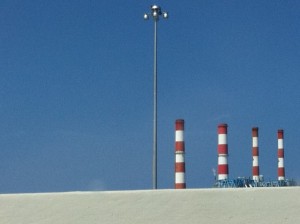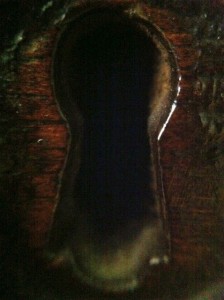The Economics of Creative Destruction (Part 4)
By Asher Crispe: August 2, 2012: Category Inspirations, Quilt of Translations
Destruction and Creative Destruction
In Jewish law, there are 39 examples of prohibited “work” on the Sabbath. Each of these general examples of melachot [acts of creation associated with the construction of the Tabernacle (Mishkan) in ancient Israel] has a myriad of fine details and special cases that are investigated in the Talmud and the subsequent strata of Rabbinic scholarship. One such prohibited activity relates to types of construction processes. Within the context of discussing what constitutes ‘building,’ the rabbis consider a special case and arrive at one of the more intriguing Sabbath laws which involves whether or not it is acceptable to destroy or demolish a structure on the Sabbath.
If one is simply destroying or tearing down an existing building with no intent to rebuild anything in its place–it would seem that this could be considered acceptable to the degree that it does not violate the prohibition of soiter or destroying. [Note: in practice the rabbis also prohibited this form of destroying because of its resemblance to destroying for the sake of rebuilding.]
If, however, there is any intent to rebuild either the same or similar structure, or something different and new, then the destruction is considered as part of the building process itself and this form of destruction does qualify as soiter. Consequently, it is prohibited on the Sabbath. In the words of the sages, it is called “soiter al minat levnot” or literally destroying for the sake of building. As such, it is the perfect expression of our concept of creative destruction.
From here, we see that the Talmudic scholars had a clear concept of creative destruction. Moreover, rather than limit this idea to the narrow sense of economics as the world of exchange value, money, commerce, finance and the like (as in the academic field), the kabbalists and chassidic masters elevate the idea of ‘economics’ to a metaphysical plane, a more figurative or abstract sense of economics, wherein there exists Divine self-limitation in the course of installing boundary conditions within Creation in order to give rise to our natural world.
The Divine Economy of Continuous Creation as Creative Destruction
The name of God that dominates the first week of Creation in the Genesis narrative is Elokim which equals 86 in gematria (the numerical equivalency of Hebrew letters when considered as a number). 86 also equals the Hebrew word ha’teva which means “Nature” (it is actually the nature as opposed to a nature). Thus, Kabbalists like Rabbi Abraham Abulafia explain, that this Divine name-identity signifies God as Nature or more precisely God as manifest through Nature, the Divine immanence (as opposed to God beyond Nature or the transcendent aspect of Divinity. By the time we get to the 7th day or Sabbath on the first week of Creation we find that this name-identity of the Divine itself “rests” (Genesis 2:3):
כי בו שבת מכל-מלאכתו אשר-ברא אלהים לעשות
This can be translated as:
…because in it [the Sabbath] He rested [a cessation] of all His ‘creative work’ [in the highly specialized sense of creative work] which (was accomplished through the) creation of [the name-identity of] Elokim [in other words, God working through the guise of Nature] in order that (everything) be made.
While admittedly a bit convoluted in translation, the original Hebrew makes a great deal of sense once we understand the secret of Divine names. Just because I may be called by different names like brother, teacher, husband etc, does not mean that I am schizoid or hiding the fact that my “I” is really multiple people. I am a singular being. Nonetheless, names denote relationships. As Nature with a capital N, the name-identity Elokim can be thought of as the overarching nature or the Nature or nature. Since, this name-identity is also associated with severity in Kabbalah, we might venture to formulate a definition of its aggregate meaning as follows:
The self-limiting of the Divine—a feature of the ‘contraction’ or tzimtzum wherein God conceales His limitless aspect of Divine revelation in order to express and reveal His power of self-limitation—engenders Nature as a Divine persona in order to constitute Creation as we know it. Throughout the week of Creation—which in both midrashic and kabbalistic sources symbolizes the entire trajectory of Jewish/world history with each day figuring as a thousand years—the name-identity of God expressed as Elokim functions as the filter through which Divine energy constantly recreates the world via creative destruction.
In this light, continuous recreation at each and every moment, something from nothing (ex nililo) implies that the judgement (Elokim also denotes judgement) or critical ‘self-assessment’ of Creation takes place for God between He and Himself (or alternatively, between His revealed transcendent aspect or the Divine name Havayah and His revealed immanent aspect or the Divine name Elokim). Like an artist who is painting a picture, then stands back and looks at it with a critical eye, only to reject it (an act tantamount to returning it to nothingness) and immediately commence painting another.
With each successive iteration, the hope would be to come closer and closer to a final version that incorporates all of the best elements learned from the previous iteration. The desired end is a final masterpiece that the artist can fully embrace with complete satisfaction. This final masterpiece assembles all of the dimensions of a truly beautiful and fully rectified world. This is the end of Nature, the time when Elokim as the dominate name-identity that’s been constituting, tearing down and reconstituting the world, can “rest” and observe a cosmic Sabbath during the seventh millennium.
Elokim as a technical term in Kabbalah serves as the Divine economy. First, it is economical as a self-limiting aspect of Divine revelation. Second, it ‘reserves judgement’ of the creative process. Third, Elokim in the artist example circulates an exchange of values in that new possibilities are continually being tried out on the canvass of Creation with the best of them being conserved. The finality of this process results in a sustainable economy or a name-identity of Elokim that can “rest” on account of the system running to perfection.
Subsequently, we could draw a parallel to the dynamics of a complex system that gradually settles into a state of equilibrium or reclaims a ‘lost’ symmetry and balance—a ‘ground state.’ This relationship between the weekdays as the history of the world and the Sabbath as the endgame of Creation, aids our understanding of the laws prohibiting creative destruction on the Sabbath. Jewish esotericism engages history as a Divine economy predicated on creative destruction.
Only by eliminating an earlier world-order or removing a previous frame of this film strip of time, can the subsequent iteration appear. A clearing is necessary so that there be room for the stage to follow. In Hegelian fashion (and we should note that Hegel was himself influenced by Kabbalah), a previous time frame is both negated, and in a some sense, preserved as it is uplifted to the subsequent time frame. Reality begets reality. History is literally ‘generational.’
The consolation of a future world that is likened in its entirety to the Sabbath, affords us the possibility of destruction without intent to rebuild. How can that represent the Messianic age?
The destruction in this case applies to the old exilic world order. As the Lubavitcher Rebbe would emphasis over and over again, ‘the true and complete redemption of the Messianic age is a redemption that will never be followed by another exile.’ A permanent status is reached that locks Creation into this redeemed state and precludes all possibility of falling back into a broken or unrectified reality. It’s not like winning a game and then resetting all the players back to the beginning so that they can play again. History, on this grand cosmological level, does not repeat itself (although there are epicycles of time during the times of exile). What is destroyed is the old sense of nature, of war and revolution, birth and death. The dialectic comes to an end.
How can the world-in-a-Sabbath-state avoid creative destruction? Everything is meant to endure forever. Eternity enters into time. Nothing is ever lost. Not just persons but experience itself is resurrected. A subsequent state of reality can be born while retaining the previous state without contradiction. We don’t need to destroy the old to create the new. They can co-exist peacefully. The world to come, the futurity of the world, embraces and may even dissolve this paradox. Disjunctive lives and lifetimes can enter into superposition. The immanent aspect of Divinity shows itself is be one with the transcendent aspect of Divinity. Havayah is Elokim. Nature itself becomes miraculous.
http://www.interinclusion.org/inspirations/the-economics-of-creative-destruction-part-5/





















;)
;)
;)
;)
;)
;)
;)
;)
;)
;)
